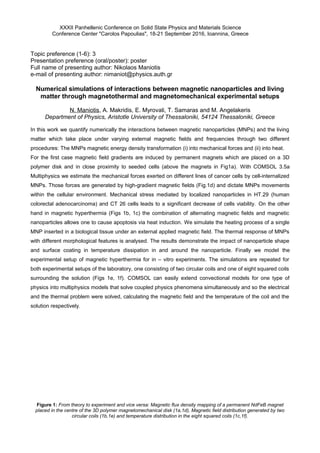Report
Share

Recommended
conference paperThe effect of magnetic field direction on thermoelectric and thermomagnetic c...

The effect of magnetic field direction on thermoelectric and thermomagnetic c...Muhammid Al-Baghdadi
Recommended
conference paperThe effect of magnetic field direction on thermoelectric and thermomagnetic c...

The effect of magnetic field direction on thermoelectric and thermomagnetic c...Muhammid Al-Baghdadi
More Related Content
Similar to Maniotis-XXXII_ABSTRACT
Similar to Maniotis-XXXII_ABSTRACT (20)
Comparative Study of Evolutionary Algorithms for the Optimum Design Of Thin B...

Comparative Study of Evolutionary Algorithms for the Optimum Design Of Thin B...
Influence of Interface Thermal Resistance on Relaxation Dynamics of Metal-Die...

Influence of Interface Thermal Resistance on Relaxation Dynamics of Metal-Die...
Micromechanical Modeling of the Macroscopic Behavior of Soft Ferromagnetic Co...

Micromechanical Modeling of the Macroscopic Behavior of Soft Ferromagnetic Co...
Analysis Of Three-Prong Events In The Heavy Ion Interaction Of 17.0 MeV U 132...

Analysis Of Three-Prong Events In The Heavy Ion Interaction Of 17.0 MeV U 132...
Numerical Model of Microwave Heating in a Saturated Non-Uniform Porosity Medi...

Numerical Model of Microwave Heating in a Saturated Non-Uniform Porosity Medi...
Magnetic domains and surface effects in hollow maghemite nanoparticles

Magnetic domains and surface effects in hollow maghemite nanoparticles
Radiation and magneticfield effects on unsteady natural

Radiation and magneticfield effects on unsteady natural
Radiation and magneticfield effects on unsteady natural

Radiation and magneticfield effects on unsteady natural
Interior Heating of Rocky Exoplanets from Stellar Flares with Application to ...

Interior Heating of Rocky Exoplanets from Stellar Flares with Application to ...
Computational electromagnetics in plasmonic nanostructures

Computational electromagnetics in plasmonic nanostructures
magnetic nano particles in bio medical applications

magnetic nano particles in bio medical applications
Hysteresis Loops for Magnetoelectric Multiferroics Using Landau-Khalatnikov T...

Hysteresis Loops for Magnetoelectric Multiferroics Using Landau-Khalatnikov T...
Maniotis-XXXII_ABSTRACT
- 1. XXXII Panhellenic Conference on Solid State Physics and Materials Science Conference Center "Carolos Papoulias", 18-21 September 2016, Ioannina, Greece Topic preference (1-6): 3 Presentation preference (oral/poster): poster Full name of presenting author: Nikolaos Maniotis e-mail of presenting author: nimaniot@physics.auth.gr Numerical simulations of interactions between magnetic nanoparticles and living matter through magnetothermal and magnetomechanical experimental setups N. Maniotis, A. Makridis, E. Myrovali, T. Samaras and M. Angelakeris Department of Physics, Aristotle University of Thessaloniki, 54124 Thessaloniki, Greece In this work we quantify numerically the interactions between magnetic nanoparticles (MNPs) and the living matter which take place under varying external magnetic fields and frequencies through two different procedures: The MNPs magnetic energy density transformation (i) into mechanical forces and (ii) into heat. For the first case magnetic field gradients are induced by permanent magnets which are placed on a 3D polymer disk and in close proximity to seeded cells (above the magnets in Fig1a). With COMSOL 3.5a Multiphysics we estimate the mechanical forces exerted on different lines of cancer cells by cell-internalized MNPs. Those forces are generated by high-gradient magnetic fields (Fig.1d) and dictate MNPs movements within the cellular environment. Mechanical stress mediated by localized nanoparticles in HT.29 (human colorectal adenocarcinoma) and CT 26 cells leads to a significant decrease of cells viability. On the other hand in magnetic hyperthermia (Figs 1b, 1c) the combination of alternating magnetic fields and magnetic nanoparticles allows one to cause apoptosis via heat induction. We simulate the heating process of a single MNP inserted in a biological tissue under an external applied magnetic field. The thermal response of MNPs with different morphological features is analysed. The results demonstrate the impact of nanoparticle shape and surface coating in temperature dissipation in and around the nanoparticle. Finally we model the experimental setup of magnetic hyperthermia for in – vitro experiments. The simulations are repeated for both experimental setups of the laboratory, one consisting of two circular coils and one of eight squared coils surrounding the solution (Figs 1e, 1f). COMSOL can easily extend convectional models for one type of physics into multiphysics models that solve coupled physics phenomena simultaneously and so the electrical and the thermal problem were solved, calculating the magnetic field and the temperature of the coil and the solution respectively. (a) (b) (c) (d) (e) (f) Figure 1: From theory to experiment and vice versa: Magnetic flux density mapping of a permanent NdFeB magnet placed in the centre of the 3D polymer magnetomechanical disk (1a,1d), Magnetic field distribution generated by two circular coils (1b,1e) and temperature distribution in the eight squared coils (1c,1f).